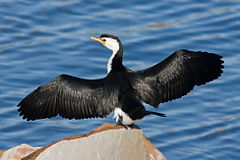
Back Kormorante Afrikaans غاقيات Arabic أفلشو ARY غاقيات ARZ Limatc (Phalacrocoracidae) AVK Qarabatdaqlar Azerbaijani སོ་བྱ། Tibetan Corbs marins Catalan Phalacrocoracidae CEB Kormoránovití Czech
| Cormorants and shags Temporal range: Late Oligocene - present
| |
|---|---|

| |
| Little pied cormorant Microcarbo melanoleucos | |
| Scientific classification | |
| Domain: | Eukaryota |
| Kingdom: | Animalia |
| Phylum: | Chordata |
| Class: | Aves |
| Order: | Suliformes |
| Family: | Phalacrocoracidae Reichenbach, 1850 |
| Type genus | |
| Phalacrocorax | |
| Genera | |
|
Microcarbo | |
| Synonyms | |
|
Australocorax Lambrecht, 1931 | |
Phalacrocoracidae is a family of approximately 40 species of aquatic birds commonly known as cormorants and shags. Several different classifications of the family have been proposed, but in 2021 the International Ornithologists' Union (IOU) adopted a consensus taxonomy of seven genera.[1] The great cormorant (Phalacrocorax carbo) and the common shag (Gulosus aristotelis) are the only two species of the family commonly encountered in Britain and Ireland[2] and "cormorant" and "shag" appellations have been later assigned to different species in the family somewhat haphazardly.
Cormorants and shags are medium-to-large birds, with body weight in the range of 0.35–5 kilograms (0.77–11.02 lb) and wing span of 60–100 centimetres (24–39 in). The majority of species have dark feathers. The bill is long, thin and hooked. Their feet have webbing between all four toes. All species are fish-eaters, catching the prey by diving from the surface. They are excellent divers, and under water they propel themselves with their feet with help from their wings; some cormorant species have been found to dive as deep as 45 metres (150 ft). They have relatively short wings due to their need for economical movement underwater, and consequently have among the highest flight costs of any flying bird.[3]
Cormorants nest in colonies around the shore, on trees, islets or cliffs. They are coastal rather than oceanic birds, and some have colonised inland waters. The original ancestor of cormorants seems to have been a fresh-water bird.[citation needed] They range around the world, except for the central Pacific islands.
- ^ Cite error: The named reference
IOUwas invoked but never defined (see the help page). - ^ "Cormorants and shags". RSPB. Retrieved 27 July 2018.
- ^ Elliott, KH; Ricklefs, RE; Gaston, AJ; Hatch, SA; Speakman, JR; Davoren, GK (2013). "High flight costs and low dive costs in auks support the biomechanical hypothesis for flightlessness in penguins". Proceedings of the National Academy of Sciences. 110 (23): 9380–9384. Bibcode:2013PNAS..110.9380E. doi:10.1073/pnas.1304838110. PMC 3677478. PMID 23690614.
© MMXXIII Rich X Search. We shall prevail. All rights reserved. Rich X Search